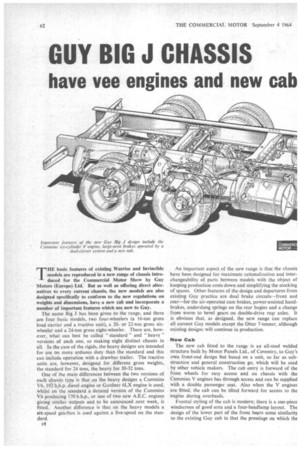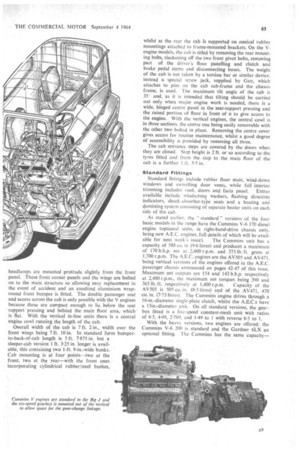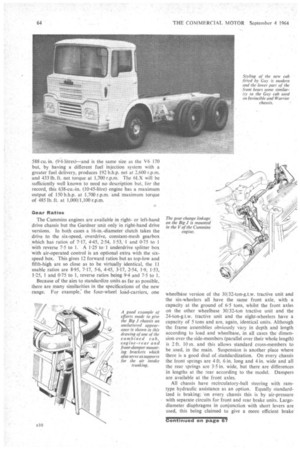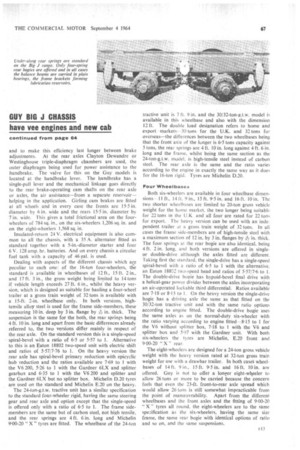GUY BIG •J CHASSIS
Page 64

Page 65

Page 66

Page 69

If you've noticed an error in this article please click here to report it so we can fix it.
have vee engines and new cab
THE basic features of existing Warrior and Invincible models are reproduced in a new range of chassis introduced for the Commercial Motor Show by Guy Motors (Europe) Ltd. But as well as offering direct alternatives to every current chassis, the new models are also designed specifically to conform to the new regulations on weights and dimensions, have a new cab and incorporate a number of important features which are new to Guy.
The name Big 3 has been given to the range, and there are four basic models, two four-wheelers (a 16-ton gross load carrier and a tractive unit), a 20or 22-ton gross sixwheeler and a 24-ton gross eight-wheeler. There are, however, what can best be called " standard " and "heavy " versions of each one, so making eight distinct chassis in all. In the case of the rigids, the heavy designs are intended for use On more arduous duty than the standard and this can include operation with a drawbar trailer. The tractive units are, however, designed for different gross weights, the standard for 24 tons, the heavy for 30-32 tons.
One of the main differences between the two versions of each chassis type is that on the heavy designs a Cummins V6, 192 b,h.p. diesel engine or Gardner 6LX engine is used, whilst on the standard a derated version of the Cummins V6 producing 170 b.h.p., or one of two new A.E.C. engines giving similar outputs and to be announced next week, is fitted. Another difference is that on the heavy models a six-speed gearbox is used against a five-speed on the standard.
An important aspect of the new range is that the chassis have been designed for maximum rationalization and interchangeability of parts between models with the object of keeping production costs down and simplifying the stocking of spares. Other features of the design and departures from existing Guy practice are dual brake circuits—front and rear—for the air-operated cam brakes, power-assisted handbrakes, underslung springs on the rear bogies and a change from worm to bevel gears on double-drive relr axles. It is obvious that, as designed, the new range can replace all current Guy models except the Otter 7-tonner, although existing designs will continue in production.
New Cab
The new cab fitted to the range is an all-steel welded structure built by Motor Panels Ltd.. of Coventry, to Guy's own front-end design but based on a unit, so far as substructure and general construction go, which will be used by other vehicle makers. The cab entry is forward of the front wheels for easy access and on chassis with the Cummins V engines has through access and can be supplied with a double passenger seat. Also when the V engines are fitted, the cab can be tilted forward for access to the 'engine during overhauls.
Frontal styling of the cab is modern; there is a one-piece windscreen of good area and a four-headlamp layout. The design of the lower part of the front bears some similarity to the existing Guy cab in that the pressings on which the headlamps are mounted protrude slightly from the front pane!. These front corner panels and the wings are bolted on to the main structure so allowing easy replacement in the event of accident and an anodized aluminium wrapround front bumper is fitted. The double passenger seat and access across the cab is only possible with the V engines because these are compact enough to lie below the seat support pressing and behind the main floor area, which is flat. With the vertical in-line units there is a central engine cowl running the length of the cab.
Overall width of the cab is 7 ft. 2 in., width over the front wings being 7 ft. 10 in. In standard form bumperto-back-of-cab length is 5 ft. 7.875 in. but a sleeper-cab version 1 ft. 3.25 in. longer is available, this containing two 1-ft. 9-in.-wide bunks. Cab mounting is at four points—two at the front, two at the rear—with the front ones incorporating cylindrical rubber/steel bushes,
whilst at the rear the cab is supported on conical rubber mountings attached to frame-mounted brackets. On the Vengine models, the cab is tided by removing the rear mounting bolts, slackening off the two front pivot bolts, removing part of the driver's floor panelling and clutch and brake pedal stems and disconnecting hoses. The weight of the cab is not taken by a torsion bar or similar device; instead a special screw jack, supplied by Guy, which attaches to pins on the cab sub-frame and the chassis frame, is used. The maximum tilt angle of the cab is 350 and, as it is intended that tilting should be carried out only when major engine work is needed, there is a wide, hinged centre panel in the seat-support pressing and the raised portion of floor in front of it to give access to the engine. With the vertical engines, the central cowl is in three sections, the centre one being easily removable with the other two bolted in place. Removing the centre cover gives access for routine maintenance, whilst a good degree of accessibility is provided by removing all three.
The cab entrance steps are covered by the doors when they are closed. Step height is 2 ft. or so according to the tyres fitted and from the step to the main floor of the cab is a further I ft. 5-5 in.
Standard Fittings Standard fittings include rubber floor mats, wind-down windows and swivelling door vents, while full interior trimming includes roof, doors and facia panel. Extras available include windscreen washers, flashing direction indicators, shock-absorber-tyloe seats and a heating and demisting system consisting of separate heater units on each side of the cab.
As stated earlier, the "standard " versions of the four basic models in the range have the Cummins V-6 170 diesel engine (optional units, in right-hand-drive chassis only, being new A.E.C. engines, full details of which will be avail able for next week's issue). The Cummins unit has a capacity of 588 Cu. in (9.6 litres) and produce's a maximum of 170 b.h.p. net at 2,600 r.p.m. and 375 lb. ft. gross at 1,700 r.p.m. The A.E.C. engines are the AV505 and AV471, being vertical versions of the engines offered in the A.E.C. passenger chassis announced on pages 42-47 of this issue. Maximum net outputs are 154 and 143 b.h.p. respectively at 2,400 r.p.m., the maximum net torques being 390 and 365 lb. ft. respectively at 1,400 r.p.m. Capacity of the AV505 is 505 cu. in. (8-3 litres) and of the AV471, 470 Cu. in. (7.73 litres). The Cummins engine drives through a 16-in.-diameter single-plate clutch, whilst the A.E.C.s have a 15in.-diameter unit. On all standard versions, the gearbox fitted is a five-speed constant-mesh unit with ratios of 6.5, 4.49, 2-769. and 1-49 to 1 with reverse 6.5 to 1.
With the heavy versions, two engines are offered: the Cummins V-6 200 is standard and the Gardner 6LX an optional fitting. The Cummins has the same capacity—
588 Cu. in. (9-6 litres)—and is the same size as the V6 170 but, by having a different fuel injection system with a greater fuel delivery, produces 192 b.h.p. net at 2,600 r.p.m. and 433 lb. ft. net torque at 1,700 r.p.m. The 6LX will be sufficiently well known to need no description but, for the record, this 638-cu.-in. (10-45-litre) engine has a maximum output of 150 b.h.p. at 1,700 r.p.m. and maximum torque of 485 lb. ft. at 1,000/L100 r.p.m.
Gear Ratios The Cummins engines are available in rightor left-hand drive chassis but the Gardner unit only in right-hand drive versions. In both cases a 16-in.-diameter clutch takes the drive to the six-speed, overdrive, constant-mesh gearbox which has ratios of 7-17, 4-45, 2.54, 1-53,' 1 and 0-75 to 1 with reverse 7.5 to 1. A 1-25 to. I underdrive splitter box with air-operated control is an optional extra with the sixspeed box. This gives 12 forward ratios but as top-low and fifth-high are so close as to be virtually identical, the 11 usable ratios are 8-95, 717, 5-6, 4.45, 3-17, 2.54, 1.9, 1.53, 1-25, 1 and 0-75 to 1, reverse ratios being 9-4 and 7.5 to 1.
Because of the aim to standardize units as far as possible, there are many similarities in the specifications of the new range. For example; the four-wheel load-carriers, one wheelbase version of the 30/32-ton-g.t.w, tractive unit and the six-wheelers all have the same front axle, with a capacity at the ground of 6-5 tons, whilst the front axles on the other wheelbase 30/32-ton tractive unit and the 24-ton-g.t.w. tractive unit and the eight-wheelers have a capacity of 5 tons and are, again, identical units. Although the frame assemblies obviously vary in depth and length according to load and wheelbase, in all cases the dimension over the side-members (parallel over their whole length) is 2 ft. 10 in. and this allows standard cross-members to be used, in the main. Suspension is another place where there is a good deal of-standardization. On every chassis the front springs are 4 ft. 6 in. long and 4 in. wide and all the rear springs are 3.5 in. wide, but there are differences in lengths at the ;ear according to the model. Dampers are available at the front axles.
All chassis have recirculatory-ball steering with ramtype hydraulic assistance as an option. Equally standardized is braking; on every chassis this is by air-pressure with separate circuits for front and rear brake units. Largediameter diaphragms in conjunction with short levers are used, this being claimed to give a more efficient brake and to make this efficiency last longer between brake adjustments. At the rear axles Clayton Dewanclre or Westinghouse triple-diaphragm chambers are used, the outer diaphragm being used for Dower assistance to the handbrake. The valve for this on the Guy models is located at the handbrake lever. The handbrake has a single-pull lever and the mechanical linkage goes directly to the rear brake-operating cam shafts on the rear axle
or axles, the air assistance from a separate reservoir— helping in the application. Girling cam brakes are fitted at all wheels and in every case the fronts are 15-5 in. diameter by 6 in. wide and the rears 15.5 in. diameter by 7 in. wide. This gives a total frictional area on the fourwheelers of 784 sq in., on the six-wheelers 1,206 sq. in. and on the eight-wheelers 1,568 sq. in.
Insulated-return 24 V. electrical equipment is also common to all the chassis, with a 35 A. alternator fitted as standard together with a 5-in.-diameter starter and four 6 V. 128 amp. hr. batteries. And on every chassis a circular fuel tank with a capacity of 46 gal. is used.
Dealing with aspects of the different chassis which are peculiar to each one: of the I6-ton four-wheelers, the standard is available in wheelbases of 12 ft., 15 ft. 2 in., and 17 ft. 3 in., the gross weight being limited to 14 tons if vehicle length exceeds 27 ft. 6 in., whilst the heavy version, which is designed as suitable for hauling a four-wheel trailer at a gross train weight of 32 tons is available with a 15-ft. 2-in, wheelbase only. In both versions, hightensile alloy steel is used for the frame side-members, these measuring 10 in. deep by 3 in. flange by Fe in. thick. The suspension is the same for the both, the rear springs being 4 ft. 10 in, long and apart from the basic differences already referred to, the two versions differ mainly in respect of the rear axle. On the standard version this is a single-speed spiral-bevel with a ratio of 6.5 or 5.57 to I. Alternative to this is an Eaton 18802 two-speed unit with electric shift and ratios of 5-57/7.76 to 1. On the heavy version the rear axle has spiral-bevel primary reduction with epicyclic hub reduction and the ratios available are 7-69 to 1 with the V6 200, 5.26 to 1 with the Gardner 6LX and splitter gearbox and 6.35 to 1 with the V6 200 and splitter and the Gardner 6LX but no splitter box. Michelin D.20 tyres are used on the standard and Michelin E.20 on the heavy.
The 24-ton-g.t.w. tractive unit has a similar specification to the standard four-wheeler rigid, having the same steering gear and rear axle and option except that the single-speed is offered only with a ratio of 6.5 to I. The frame sidemembers are the same but of carbon steel, not high tensile, and the rear springs are 4 ft. 6 in. long and Michelin 9'.00-20 " X " tyres are fitted. The wheelbase of the 24-ton
tractive unit is 7 it. 9 in. and the 30/32-ton-g.t.w. model is available in this wheelbase and also with the dimension 12 ft. The double load designation refers to home and export markets--30 tons for the U.K. and 32 tons for overseas—the differences between the two wheelbases being that the front axle of the longer is 6-5 tons capacity against 5 tons, the rear springs are 4 ft. 10 in. long against 4 ft. 6 in. long and the frame, whilst being the same section as the 24-ton-g.t.w. model, is high-tensile steel instead of carbon steel. The rear axle is the same and the ratio varies according to the engine in exactly the same way as it does for the 16-ton rigid. Tyres are Michelin D.20.
Four Wheelbase,
Both six-wheelers are available in four wheelbase dimensions-11 ft., 14 It. 9 in., 15 ft. 9-5 in. and 16 ft. 10 in. The two .shorter wheelbases are limited to 20-ton gross vehicle weight for the home market, the two longer being suitable for 22 tons in the U.K. and all four are rated for 22 tons for export. The heavy version can be used with an independent trailer at a gross train weight of 32 tons. In all cases the frame side-members are of high-tensile steel with a maximum section of 12 in. by 3 in. flanges by A. in. thick. The four springs at the rear bogie are also identical, being 4 ft. 2 in. long, and both versions are offered in singleor double-drive although the axles fitted are different. Taking first the standard, the single-drive has a single-speed spiral-bevel with a ratio of 6.5 to 1 with the alternative, an Eaton 18802 two-speed head and ratios of 5.57/7.6 to I. The double-drive bogie has hypoid-bevel final drive with a helical-gear power divider between the axles incorporating an air-operated lockable third differential. Ratios available are 7.18 or 8.15 to I. On the heavy version the single-drive bogie has a driving axle the same as that fitted on the 30/32-ton tractive unit and with the same ratio options according to engine fitted. The double-drive bogie uses the same axles as on the normal-duty six-wheeler with the ratio varying according to engine fitted--8-15 to 1 for the V6 without .splitter box, 7-18 to. 1 with the V6 and splitter box and 5.97 with the Gardner unit. With both six-wheelers the tyres are Michelin, E20 front and 9-00-20 `! X" rear.
The eight-wheelers are designed for a 24-ton gross vehicle weight with the heavy version rated at 32-ton gross train weight for use with a drawbar trailer. In both case wheelbases of 14 ft. 9 in., 15 ft. 9.5 in. and 16 ft. 10 in. are offered. Guy is not to offer a lonaer eight-wkeeler to allow 26 tons or more to be carried because the concern feels that even the 23-ft. front-to-rear axle spread which would allow 26 tons is still somewhat impracticable from the point of manteuvrability. Apart from the different wheelbases and the front axles and the fitting of 9.00-20 "X" tyres all round, the eight-wheelers are to the same specification as the six-wheelers, having the same size frame, the same rear bogie with identical options of ratio and so on, and the same suspensions.
































































































































